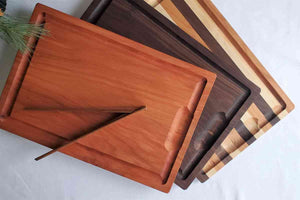- Continue Shopping
- Your Cart is Empty
All About Charcuterie and Charcuterie Boards
Ditch the Huge Charcuterie Board
If your serving board needs to be huge, why not just use your table-top? Unroll brown paper down the center and add whatever wood boards and bowls are in your cupboard. Voila! A grand grazing board is sparked from the place where necessity and creativity meet up.
Before huge, complicated layouts on charcuterie boards became a “thing” on Instagram or TikTok, charcuterie and cheese boards were much simpler affairs, usually simple wooden platters or plates with just a few selections.
The origin story of the charcuterie board is a humble one and continues to call for a certain informality in both the layout and the presentation, although you will certainly see charcuterie and grazing boards at the most elegant of weddings and special occasions.
The Origin of Charcuterie
Charcuterie is a French term dating to the 1400s which literally means cooked flesh (ick) and most often refers to various selections of pork, including the internal organs (waste not want not). Today, think pork chop, bacon and pate. But long before that, the Romans were smoking and salting various meats to preserve them. And modern-day Italy still gives us salami, pepperoni, and soppressata among other tasty offerings. Along the way, different cultures have added to our appreciation of charcuterie. Scandinavian smorgasbords have enlightened us to the merits of rye bread along with herring and smoked fish, while Spain gives us olives, chorizo and Iberian ham. Even German delicatessen gave meat and cheese platters (think cold cuts) new life at informal backyard gatherings in the 1950s and 60s. And I’ve been known to include cole slaw on my grazing table.
Somewhere between then and now, the charcuterie board has evolved from a simple meat and/or cheese boards to a mainstay of bars, restaurants and home entertaining.
A Board for the Times
It’s no wonder that charcuterie boards are a sign of the times. A well-crafted charcuterie board is aptly suited to our modern modes of informal entertaining. Our present day definition of charcuterie has morphed to include a wide understanding of the types of foods that might be offered. Although charcuterie is no longer limited to cheese or cured meats, we still like the traditional connotation of charcuterie as a presentation on a wooden board or platter.
Tips for Your Charcuterie Board
Start with a Theme: Picking a theme country - most obviously Italy, Spain, or France - brings cohesion to a board and helps narrow down your choices.
Vary the Texture of the Cheeses: So many ways to choose cheese for a board, but certainly a basic rule of thumb is one soft, one medium and one hard cheese.
2 or 3 Meats is Enough: Just like there’s enormous variety in cheeses, there are umpteen meats to choose from, but a few is enough. More may overwhelm.
Keep the Carbs Simple: The tastes of your cheeses and meats should be the stars of the show.
Add Acid: Olives, cornichons and pickled vegetables will help balance the fat in either cured meats or cheeses.
And Something Sweet: Fresh or dried fruits and a fig jam or honey are traditional adds to a charcuterie board.
Choosing Your Charcuterie Board
Our small charcuterie board will easily serve 6-8 while our larger board or Lazy Susan will serve a crowd. And as we stated at the beginning, no need to go bigger, just go creative!
About New Hampshire Bowl and Board – Our Made in the USA wood bowls, charcuterie boards and Lazy Susans are designed for beautiful presentations on your table and special occasion gift giving. Paulie the Bowl Man is a real person (not always camera ready). Call him and he will be pleased to hear your voice and chat about cheese, salad and charcuterie.

Personalized Charcuterie Board Choose Cherry, Walnut, or Multi-wood
from $ 119.99

from






